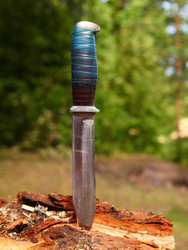Hunting Knives – Ancient and Reliable
28th Feb 2017
The hunting knife predates all weapons that are not stones or clubs. It is one of our ancestors’ greatest ever creations. Used for skinning game and self-preservation, the hunting knife’s function has not changed much over the centuries. The first metal hunting knives dates to 2000 BC and iron was extensively used to make knives as far back as the Iron Age (1000–800 BC). But, iron bent easily. A stronger, more durable knife was needed. Enter the good old Vikings. They were among the first to carbonize iron, which hardened the blade and improved its rigidity and sharpness.
The modern hunting knife typically features a rigid, single-edged blade with a large handle for ease of gripping. The unsharpened portion (tang) extends through the handle and strengthens the grip. Other knives are also used but the straight hunting knife remains the number one choice for hunting aficionados.
The watershed moment for hunting knives was the Bowie Knife, around the early 19th century. Jim Bowie’s most significant creation served the dual purpose of hunting and self-defense. The Bowie Knife typically features a large fixed blade and a clip point. Some of these knifes also tend to exhibit an S-guard, an “S”-shaped piece between the blade and the handle which is designed to deflect the assailant’s blade from his hand, a feature that is not required when hunting animals.
The Bowie Knife is not the only major development in the recent history of hunting knives. There is the all-purpose Swiss Army Knife – the folding knife/ miniature toolbox – which came into existence around the late 19th century. These knives fall short of being primary hunting weapons (unless, of course, you are MacGyver) but hunters still carry them for field dressing, butchering, camping, and woodwork.
Like the Bowie Knife is an important part of American history, there are other knives associated closely with other countries (though some may not necessarily be used for hunting). The Philippines has its long, slim bolo knives that are suited to jungle work. South American machetes are used to clear dense rain forest vegetation. Nepal has given us the famous kukris used by the Gurkha army.
Knife technology has evolved greatly and today there are several manufacturers offering a wide variety of configurations and materials. We will soon be sharing a post on how to make hunting knives, including information on knife making supplies etc.


 Gift Cards
Gift Cards